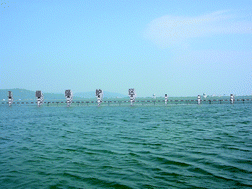Sources, partitioning and toxicological risk of 15 priority polycyclic aromatic hydrocarbons (PAHs) in surface sediments from drinking water sources of Taihu Lake, with an area of 2428 km2 located in the most developed and populated area of China, were studied, and the results were compared with those in other lakes of China and the USA. Concentrations of the 15 PAHs in sediments ranged from 436.6 to 1334.9 ng g−1 (dw). Gasoline combustion, coal combustion, diesel combustion from shipping and spillage of petroleum were apportioned to be the main sources of PAHs in this area by principal component analysis, which contributed 35.19%, 26.43%, 25.41% and 12.97% to the PAH sources estimated by further multiple linear regression. Levels of PAHs in sediments were negatively correlated with contents of clay and fine silt (<16 μm), while positively with contents of medium silt, coarse silt and sand (>16 μm). Humin with size larger than 16 μm contained the largest part of the burden of PAHs in sediments, but the specific partitioning domain (bound humic acid, lipid or insoluble residue) depended on properties of organic matter reflected by optical absorbance at 465 and 665 nm. Total toxic benzo[a]pyrene equivalent (TEQcarc) of the carcinogenic PAHs in sediments varied from 31.8 to 209.3 ngTEQcarc g−1. Benzo[a]pyrene and dibenzo[a,h]anthracene contributed 45.36 and 25.31% to total TEQcarc, posing high toxicological risk to this area.

You have access to this article
 Please wait while we load your content...
Something went wrong. Try again?
Please wait while we load your content...
Something went wrong. Try again?


 Please wait while we load your content...
Please wait while we load your content...